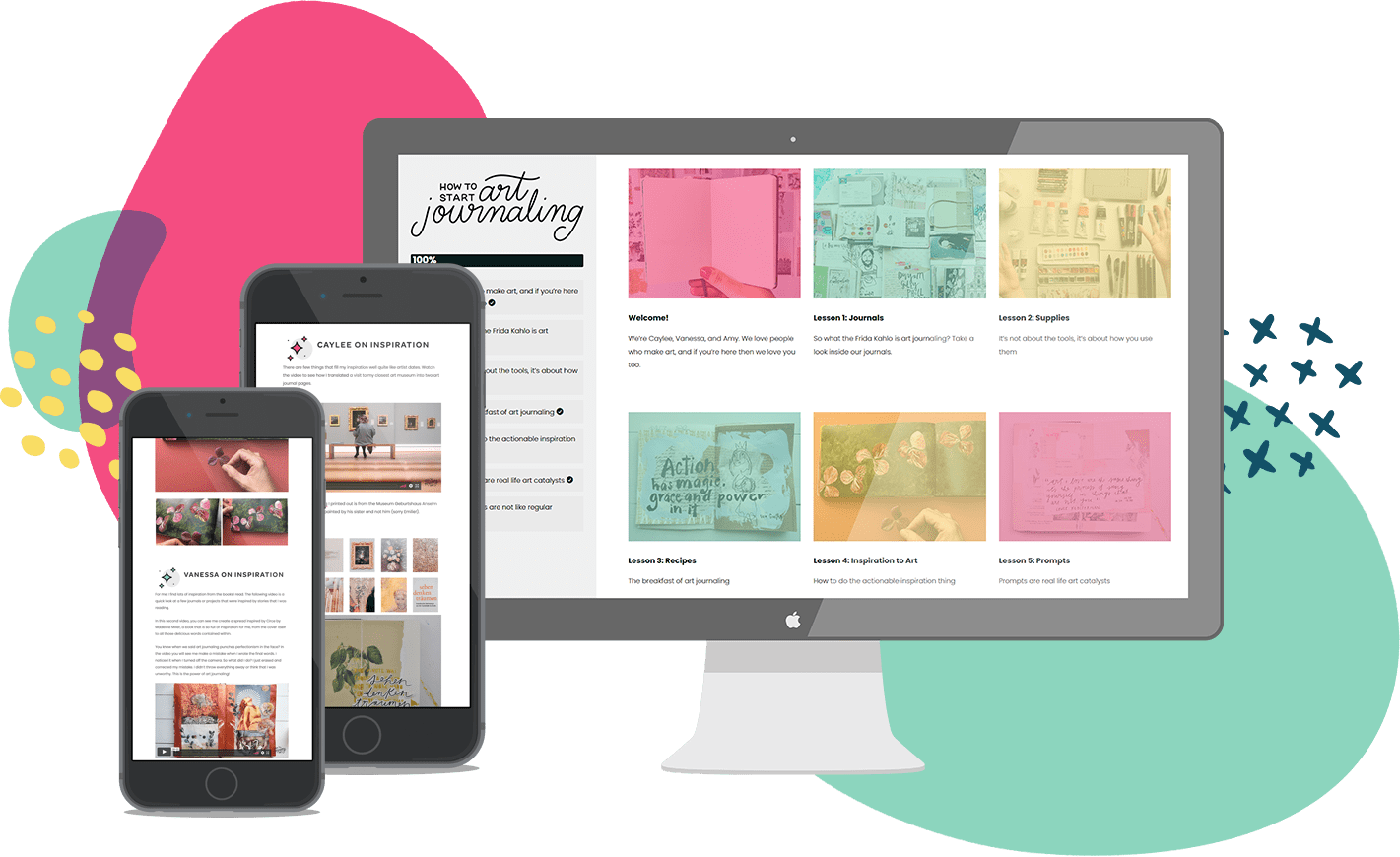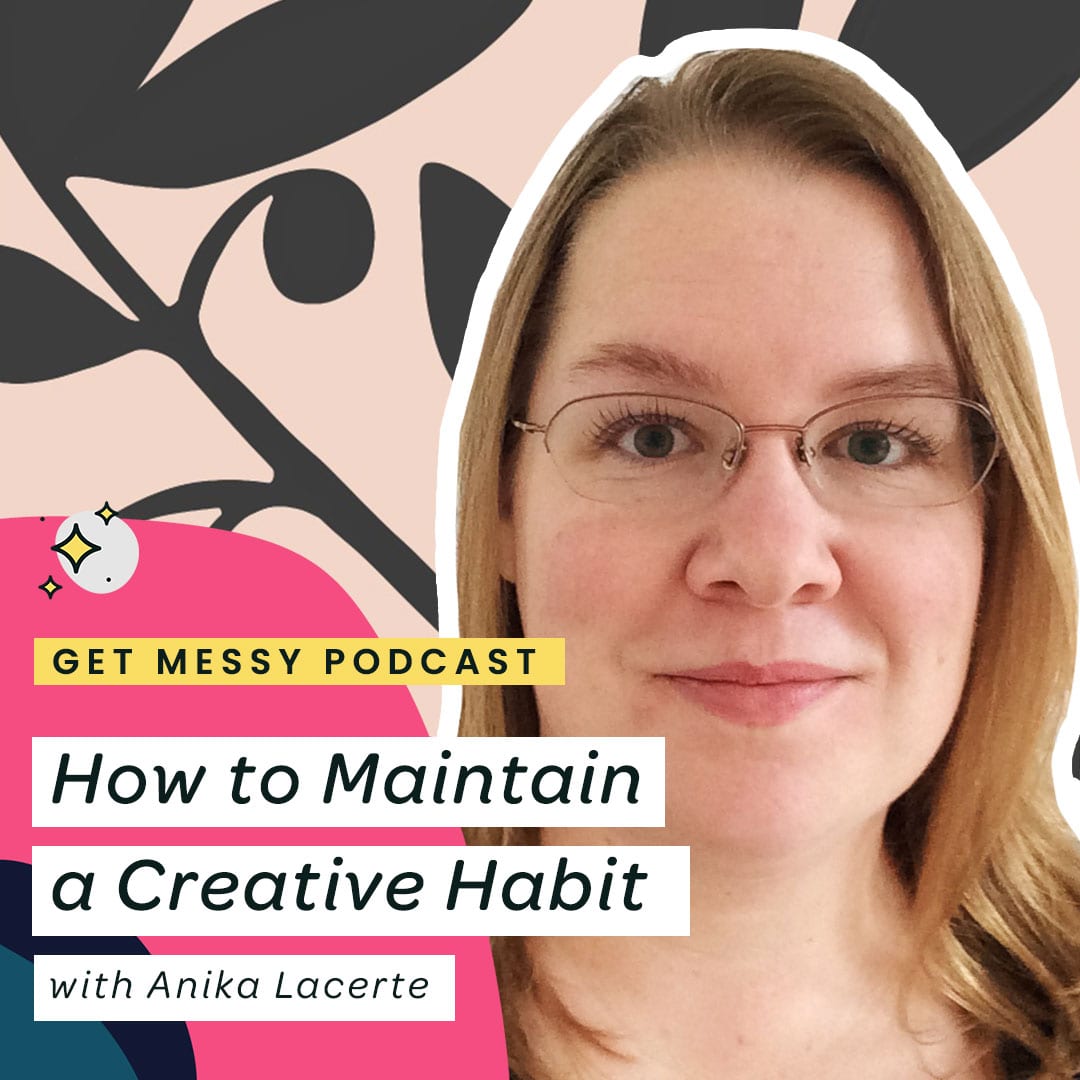In this podcast, I chat to Anika Lacerte about creative habit. As someone who is currently on her 9th 100 day project, Anika is kind of an expert at it. She shares her top 16 ways for fitting art into your life every single freaking day. Scroll down to download the PDF and keep it with you to refer back to.
Podcast Show Notes
Anika started by watching people make art every day. She desired the habit and discipline of consistent making.
“WHAT I MADE WAS ALMOST LESS IMPORTANT THAN MAKING EVERY DAY.”
– ANIKA LACERTE
How can you take the desire to create into part of your life as a mom of two kids?
Start with sharing weekly. There is something about sharing your work publicly that works and helps keep you accountable.
Anika started by drawing in a sketchbook at night before going to bed, however it was not the best time due to being tired and her ability to think of what to create wasn’t great. After getting an ipad, she started drawing in the morning. She missed the sound and feel of the paper and found the blank screen more intimidating than a blank sketchbook page. She took pictures of blank sketchbook papers, added it to a layer in Procreate and this helped her feel less intimidated.
Is a creative habit for everyone?
If you want to be an artist, if you want to create a lot of work and for it to be a part of your life – you do need a creative habit. It doesn’t need to be an hour every day.
“If you can find a small amount of time every day – it will become a part of your identity.”
– Anika Lacerte
Creating a lot of work helps you to become less insecure about what you create due to the amount of work you produce – you are less likely to be attached to a piece of work or get offended if someone does not like it.
Keep track of interesting words or phrases so that you have options to pick from early in the morning. Set an alarm to get up early and create.
If you are in need of sleep, find 10 minutes during your day that works best to create something.
“It’s not always a magical moment but I’m choosing to show up. Whether it becomes magical or not is irrelevant.”
– Anika Lacerte
[convertkit form=1448153]
16 Ways to Maintain a Daily Creative Habit
1. Set the bar low.
Choose a daily habit that seems really easy. This will make it easier to become a habit. Start really small – even if it’s only five minutes a day. Try doing something every day for a week, then evaluate. Gradually set your alarm to get up earlier in the morning. Maybe your two minute sessions are used as preparation for when you have more time to create. Set the bar low. Choose a daily habit that seems really easy. This will make it easier to become a habit. Start really small – even if it’s only five minutes a day. Try doing something every day for a week, then evaluate. Gradually set your alarm to get up earlier in the morning. Maybe your two minute sessions are used as preparation for when you have more time to create.
2. Limit the scope of the project.
For example, if you are painting, limit the colours you will use or the size of the paper or sketchbook.. Focus on one skill to develop at a time. Rotate your art supplies, instead of using all your tools, pick a tool to focus on each month. By limiting your supplies, you save time instead of spending too long making decisions.
3. Try habit stacking to set yourself up for success.
What habit could add your new creative habit to? For example, draw while you wait for the kettle to boil, knit on your lunch break, take photos on your walk. Set an alarm to remind yourself until it becomes a habit.
4. Work at your best time of day.
Set yourself up for success by choosing time of day wisely. Be flexible. If you try something that didn’t work, try something else until it works. The habit is not about waking up early – it’s about creating so if it’s not working for you, change it. If the time does not work, don’t drop the whole habit but find a better time that works for you.
5. Know yourself and what works for you in this season.
What is your definition of success now? What are you willing to give up now to allow you more creative time? Be realistic about what works for you now.
6. Evaluate what has and hasn’t been working.
This is an ongoing step, not just at the beginning. After evaluating, make changes if necessary. What worked and what didn’t work. Don’t be afraid to make changes.
7. Try a new creative practice.
What works in one season may change. What other medium can you use? Are there any other creative skills that you want to learn?
8. Be realistic about projects you don’t have time for.
Put away projects you don’t have time for. Don’t let yourself get hung up on projects you don’t have time for. It doesn’t mean you can’t come back to something.
9. Give yourself a jumpstart by choosing one thing to do the night before.
Is there something you need to print out? Tools you could gather? Workspace you could clear off? Device that needs to be charged? Giving yourself a head start for the next day is a better use of time.
10. Choose to value whatever time you do have.
Set up a space you can use if you have an unexpected 5 minutes to make something. If you have little kids, can you find a surface that’s too high for the kids to reach where you can keep ongoing projects open? Or use a clear plastic box to store work in progress. I keep my ideas in the Notes app on my phone so I can add to it at any time. “Things take however long you give them.” Store ideas to use later. If you don’t write it down you may not remember at a later stage.
11. Create before you consume.
Don’t check social media before you make something. You’ll be kinder to yourself and more confident to post your work when you’re not comparing it to someone else’s.
12. Share your work.
Create a hashtag. Create one that no one else will use if possible – maybe put your name in it. Create hashtags for projects that you do.
13. Make a plan B.
Make a list of project options for expected and unexpected life events. This is especially important if you’re expecting to move, have a baby, go on vacation, etc. It’s also helpful to plan for different seasons, like what will creating look like for you in winter or summer? Consider learning a craft that is move-friendly or baby-friendly. Knitting, drawing or embroidery are quiet and don’t require a lot of space. Make a travel kit of supplies. Be gentle with yourself if you do fall a bit behind and need to catch up. It is important to know when you need to show some kindness towards yourself and when you need to push yourself.
14. Use screen time strategically to entertain the kids.
Spend the screen time being creative (NOT DOING HOUSEWORK!).
15. Work in batches.
If you paint, spend time preparing canvases, if you sew, spend time cutting out fabric for all the projects, if you take photos, edit all at once, etc.
16. When you can’t create, do all the things you don’t want to be doing when you have time to create.
Tell yourself that doing this housework now will mean you don’t have to think about it when you’re creating. Create an environment where you can create without feeling conflicted.
“IF ANYONE IS WILLING TO PUT IN FIVE MINUTES A DAY, THEY WILL CREATE MAGIC. “
– ANIKA LACERTE





